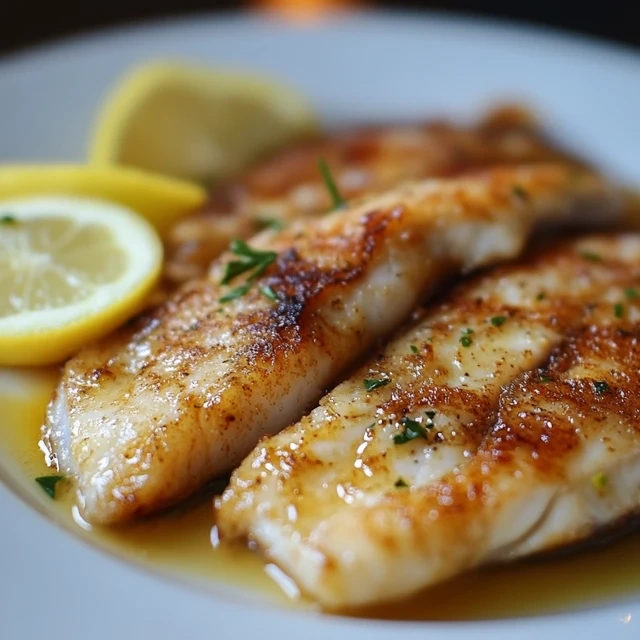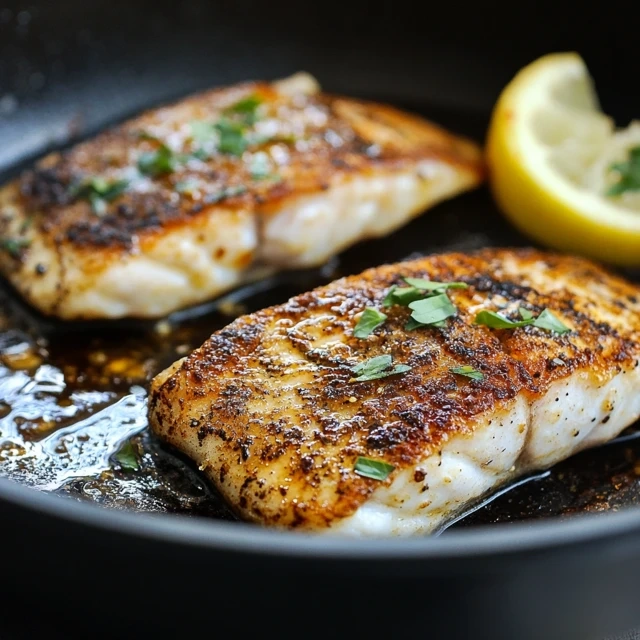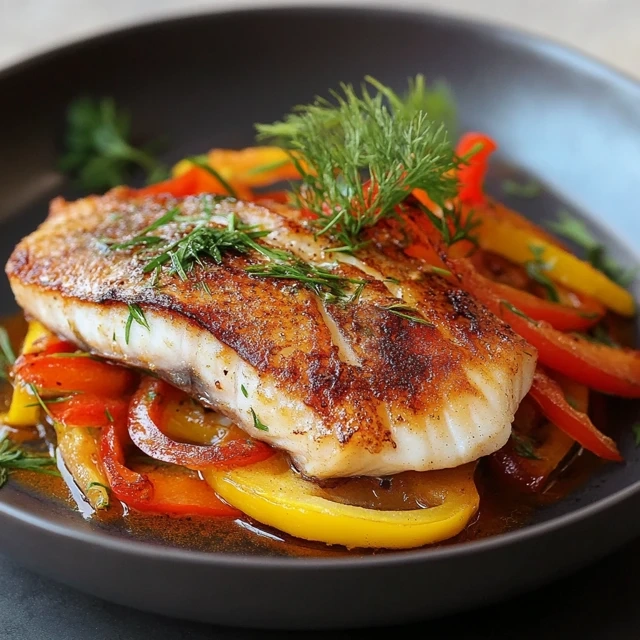Ever wondered how chefs make that golden, crispy fish dish? Pan-Fried Fish is more than cooking—it’s an art. It turns simple seafood into a masterpiece.
Learning to pan-fry fish can make your cooking amazing. With the right steps, you can make fish that’s crispy outside and moist inside.
Key Takeaways
- Pan-frying creates a delicious crispy crust on fish
- Total cooking time is under 20 minutes
- Choose fish fillets around 5 ounces for best results
- Temperature control is crucial for perfect texture
- Proper breading techniques ensure maximum flavor
Essential Guide to Selecting the Right Fish for Pan-Frying
Choosing the perfect fish for pan-frying is an art. It combines flavor, texture, and nutrition. Your choice greatly affects the dish’s taste and quality.
A well-lit kitchen counter featuring an assortment of freshly pan-fried fish filets in the foreground. The fish varieties include crispy-skinned salmon, flaky white cod, and delicate sole. Bright natural light streams in from the side, creating a warm, appetizing atmosphere. In the middle ground, various cooking utensils, seasonings, and a drizzle of lemon juice suggest the process of pan-frying. The background showcases a minimalist, modern kitchen setting with clean lines and muted tones, allowing the focus to remain on the hero ingredients. The overall composition emphasizes the diverse textures and flavors of expertly pan-fried fish.
Not all fish is good for pan-frying. Some stand out for their taste and health benefits. They offer healthy proteins and omega-3 fatty acids.
Best Fish Varieties for Pan-Frying
- Pacific Cod: Mild, sweet flavor with large flaky texture
- Halibut Cheeks: Rich, buttery experience
- Trout: Delicate white fish that crisps beautifully
- Tilapia: Mild taste, versatile with seasonings
- Branzino: Mild and easy to fry whole
Understanding Fish Thickness and Texture
The thickness of your fish fillet is key for perfect pan-frying. Aim for fillets less than 1.5 inches thick. This ensures even cooking and a crispy exterior.
Fresh vs. Frozen Fish Considerations
Fresh fish is best, but high-quality frozen fish is a good alternative. Look for IQF options. They keep the fish’s texture and nutrition.
Pro tip: Avoid dense fish like tuna or salmon. They dry out fast. Choose white, flaky fish for crispy fillets full of healthy proteins.
The Science Behind Perfect Pan-Fried Fish

An expansive stainless steel kitchen counter, illuminated by a warm, diffused overhead light, serves as the stage for an arresting display of scientific cooking techniques. In the foreground, a delicate white fish fillet sizzles in a cast-iron pan, its crisp, golden-brown exterior bearing the hallmarks of perfect pan-frying. Surrounding the pan, an array of tools and ingredients – a digital thermometer, lemon wedges, and a scattering of aromatic herbs – hint at the precise, data-driven approach to achieving the ultimate in texture and flavor. In the background, a sleek, minimalist appliance and the clean, ordered lines of the kitchen convey a sense of controlled experimentation, where the laws of physics and chemistry are harnessed to craft the ultimate pan-fried fish experience.
Learning about cooking science can change how you make crispy fish fillets. The magic comes from a chemical process called the Maillard reaction. It turns your fish into a golden-brown dish.
The Maillard reaction happens when proteins and sugars in the fish meet high heat. This science creates the brown crust that makes crispy fish fillets so tasty. It involves amino acids and sugars reacting to make deep flavors and a crispy outside.
- Protein denaturation starts at around 140°F (60°C)
- Optimal frying temperature is between 350°F to 375°F
- Surface moisture greatly affects crispy texture
Several factors are key to making perfect crispy fish fillets:
- Heat distribution: Even temperature prevents uneven cooking
- Moisture control: Drying the fish increases crispiness
- Protein structure: Knowing how heat changes fish proteins
The secret to crispy fish like restaurants is managing these scientific rules. By controlling heat, moisture, and protein reactions, you can make your cooking as good as a pro’s.
Essential Equipment and Tools for Success
Mastering home cooking starts with the right tools. For pan-frying fish, choosing the right equipment boosts your skills. It makes cooking safer and more precise.
Having professional-grade tools turns home cooking into an art. Let’s look at the key equipment for better fish-frying.
Recommended Pans and Utensils
For great pan-frying, get cookware that heats evenly. Here are the must-haves:
- Heavy-based skillet (preferably 10-inch cast iron or stainless steel)
- Long-handled fish spatula for delicate turning
- Tongs with silicone tips to prevent scratching
- Stainless steel or wooden cutting boards
Temperature Control Tools
Controlling temperature is key in cooking. Here are the tools you need:
- Digital infrared thermometer
- Instant-read meat thermometer
- Heat-resistant silicone mat
Safety Equipment
Stay safe while cooking with these must-haves:
- Splatter screen to prevent oil burns
- Heat-resistant kitchen gloves
- Fire extinguisher rated for kitchen fires
- First aid kit
Pro tip: Invest in quality tools that will last. While initial costs might be higher, durable equipment pays off in long-term cooking performance and safety.
Preparing Your Fish for Pan-Frying

Preparing your fish for pan-frying is key to a tasty meal. It starts with a few important steps. These steps can greatly improve your cooking.
First, pick your fish wisely. Go for fresh fillets, about 6 ounces each. This size is perfect for pan-frying. Then, dry the fish with paper towels. This step is crucial for a crispy, golden exterior that keeps the fish moist.
- Select fresh fish fillets
- Remove excess moisture with paper towels
- Inspect for any remaining bones
- Check fish for consistent thickness
Seasoning is the next step. Sprinkle salt and pepper on both sides of the fish. Add light seasonings that enhance the fish’s taste. A good mix includes:
- 1 teaspoon paprika
- 1/2 teaspoon garlic powder
- 1/2 teaspoon onion powder
By drying and seasoning your fish right, you make a dish that’s both tasty and well-made. This way, you turn simple seafood into a memorable meal.
The Ultimate Breading Technique
Making crispy fish fillets is more than just tossing fish in a pan. The right breading technique turns simple seafood into a feast for the senses. It adds a crunchy texture and keeps flavors locked in.
Three-Step Breading Process
To make crispy fish fillets, follow a three-step breading method. This method ensures a perfect coating that will highlight your dish:
- Flour Dredging: Coat the fish in seasoned flour to create a dry surface
- Egg Wash: Dip the floured fish into beaten eggs for adhesion
- Breadcrumb Coating: Roll in seasoned breadcrumbs for ultimate crispiness
Secret Tips for Coating Adhesion
To get seasonings to stick, you need to be precise. Pat your fish dry before breading to remove excess moisture. Then, refrigerate the breaded fish for 20-30 minutes. This helps the coating bond firmly.
Seasoning Strategies
Boost your crispy fish fillets with smart seasoning choices. Here are some flavor-packed options:
| Seasoning Category | Recommended Ingredients |
|---|---|
| Classic Blend | Salt, black pepper, garlic powder |
| Spicy Kick | Cayenne, paprika, chili powder |
| Herb-Infused | Dried parsley, thyme, oregano |
The secret to amazing breaded fish is in the technique, temperature, and seasoning. Try different flavors to find your favorite crispy fish fillets.
Pan-Fried Fish: The Perfect Method
Mastering pan-fried fish needs precision and knowing the right cooking techniques. To get a crispy outside and a moist inside, you must prepare carefully and cook with control.
First, pick the right pan – a heavy-bottomed non-stick skillet is best. Make sure your pan is clean and dry before you start. Moisture can stop the fish from getting that crispy crust.
- Preheat the pan to 140°C (280°F)
- Use high smoke point oils like sunflower oil
- Dry fish skin thoroughly before cooking
- Avoid overcrowding the pan
The cooking process needs your full attention. Press the fish skin gently with a spatula in the first 30 seconds to stop it from curling. Cooking time usually takes between 3-5 minutes, based on the fish’s thickness.
Look for signs that the fish is done: golden-brown edges, opaque flesh, and an internal temperature of 145°F. These signs mean the fish is cooked just right. The Maillard reaction makes those tasty browning flavors that make pan-fried fish so good.
Remember, the more you practice, the better you’ll get at pan-frying fish. Each try will help you get better and more confident in making dishes like a pro at home.
Oil Selection and Temperature Control

Mastering pan-frying fish requires choosing the right oil and keeping the temperature just right. Your cooking skills will really stand out when you do.
Choosing the perfect oil is key for a crispy, golden-brown fish exterior. Not all oils are good for pan-frying.
Best Oils for Pan-Frying
- Canola oil: High smoke point of 460°F
- Vegetable oil: Versatile with 400-450°F smoke point
- Avocado oil: Excellent heat tolerance up to 520°F
- Peanut oil: Neutral flavor with 450°F smoke point
Maintaining Optimal Temperature
Temperature control is the secret to perfect pan-fried fish. The ideal frying temperature is between 350°F and 375°F. This range helps you get a crispy outside and a moist inside.
Here are some temperature tips:
- Use a kitchen thermometer to monitor oil temperature
- Look for a shimmering effect in the oil, not smoking
- Adjust heat to maintain consistent temperature
- Avoid overcrowding the pan to prevent temperature drops
By mastering these techniques, you’ll make your fish amazing. You’ll get restaurant-quality results right in your kitchen.
Mastering the Flip: Timing and Technique
Flipping fish in a pan needs precision and skill. You must know when to turn the fillet and keep it delicate. Good cooking skills are key to a perfectly cooked fish.
Here are the signs your fish is ready to flip:
- The fish moves easily when gently nudged with a spatula
- Bottom edges appear golden brown and crispy
- Protein begins to look opaque around the edges
When flipping, follow these expert tips:
- Use a thin, wide spatula to support the entire fillet
- Move slowly and confidently in one smooth motion
- Tilt the pan slightly to help guide the fish
After flipping, cook the second side for about 3-4 minutes. The fish should reach an internal temperature of 145 degrees Fahrenheit. Pro tip: Resist the urge to move the fish frequently during cooking. This helps create a crispy exterior and keeps the fish from breaking.
Different fish types need different handling. Thicker fish like salmon take longer, while thinner fish like sole cook faster. Mastering these skills takes practice and patience.
Achieving the Perfect Golden Crust

To make crispy fish fillets, you need precision and to know the right cooking techniques. These techniques turn a simple meal into a work of art. The first step is to know when the fish is done and to control the temperature well.
To get that golden crust, pay close attention to a few important things. When frying fish, you want a crispy outside and a soft inside.
Visual Indicators of Doneness
Here are the key signs that your fish is cooked just right:
- Golden-brown color all over
- Crisp edges with a shiny look
- Fish that slides out of the pan easily
- Flesh that flakes when pressed gently
Temperature Testing Methods
There are two ways to make sure your fish is cooked perfectly:
- Internal Temperature Check: Use a digital thermometer to check the fish’s thickest part. It should be 145 degrees Fahrenheit.
- Flaking Test: Press the fish with a fork. If it flakes easily, it’s cooked right.
Experts say not to overcrowd the pan. This can drop the oil’s temperature and stop the fish from getting crispy. Use a heavy skillet and keep the temperature around 350°F for the best results.
Common Mistakes to Avoid
Mastering home cooking fish means knowing common mistakes. These errors can turn a great meal into a bad one. Many home cooks make these mistakes without realizing it.
Here are key errors to watch out for when pan-frying fish:
- Overcrowding the pan: Too many fish fillets together means bad heat circulation and uneven cooking
- Using oil at the wrong temperature, leading to soggy or burnt fish
- Moving fish too much during cooking, causing the crust to break apart
- Failing to pat fish dry before cooking, leading to a soggy exterior
Temperature control is key in cooking fish. Preheat your pan for three to five minutes over medium-high heat. This creates the best cooking environment. Cooking fish too low can make it rubbery and unpleasant.
Handling fish with care is important. Don’t season too early, as it can make the fish dry. Season when it’s about 80% cooked to keep it juicy.
Pro tip: Use a food thermometer to check the fish’s internal temperature. It should be 145 degrees Fahrenheit. This ensures your seafood is safe and perfectly cooked every time.
Conclusion
Learning to pan-fry fish can make your home cooking amazing. It lets you make crispy, tasty meals easily. You just need to know about temperature, fish choice, and breading.
Getting better at cooking takes practice and confidence. You can try different fish like salmon or cod. Pan-frying can also be healthy if done right, keeping nutrients in and oil out.
As you get better, pan-frying becomes a fun journey. Try it with salads, veggies, or grains for a great dinner. Your kitchen is ready to make simple fish into a fancy dish.
FAQ
What are the best fish varieties for pan-frying?
The best fish for pan-frying are cod, halibut, salmon, and tilapia. They have firm textures that cook well. Look for thick fillets for even cooking and a crispy crust.
How do I prevent my fish from sticking to the pan?
Dry your fish well before cooking. Use a non-stick pan or a seasoned cast-iron skillet. Heat the oil until it shimmers but doesn’t smoke. A light flour or breadcrumb coating helps prevent sticking and adds crispiness.
What’s the ideal oil temperature for pan-frying fish?
Heat the oil to 350-375°F (175-190°C) for pan-frying fish. This temperature gives a crispy exterior without burning. Use a thermometer or look for shimmering oil and a sizzle when adding fish.
How long should I cook fish when pan-frying?
Cook fish for 3-4 minutes per side for most fillets. It’s done when it reaches 145°F (63°C) and flakes with a fork. Thinner fillets cook faster, while thicker ones take longer.
Can I use frozen fish for pan-frying?
Yes, use frozen fish but thaw it first and pat it dry. Thaw in the fridge or under cold water. Dryness is key for a crispy exterior.
What’s the best way to season fish before pan-frying?
Season with salt, pepper, and herbs or spices just before cooking. Use paprika, garlic powder, or lemon zest to enhance flavor without overpowering the fish.
How can I tell if my fish is cooked properly?
Check for a golden-brown exterior and an internal temperature of 145°F (63°C). The fish should flake easily and be moist and tender.
What are common mistakes to avoid when pan-frying fish?
Don’t overcrowd the pan, use cold oil, and don’t move the fish too much. These mistakes can make the fish soggy and greasy. Give each fillet space and cook without constantly flipping.
Free Body Calculator – Know Your Body
Wondering if your body is in a healthy range? Use our Free Body Calculator to find out if you’re fit, normal, or need a lifestyle change. Get personalized tips, calorie targets, and your ideal protein, carbs, and fat intake – all in seconds.
Try Free Body Calculator Now
How to Make Perfectly Golden Pan-Fried Fish Every Time
Ingredients
- 4 white fish fillets tilapia, cod, catfish, or haddock
- ½ cup all-purpose flour
- ¼ cup cornmeal optional, for extra crunch
- 1 teaspoon garlic powder
- 1 teaspoon paprika
- ½ teaspoon salt
- ½ teaspoon black pepper
- ½ teaspoon cayenne pepper optional, for heat
- 1 large egg
- 2 tablespoons milk
- ½ cup vegetable oil or more, for frying
- Lemon wedges for serving
- Fresh parsley for garnish (optional)
Instructions
- Step 1: Prepare the Fish
- Pat the fish fillets dry with a paper towel to remove excess moisture.
- Season both sides with a light sprinkle of salt and pepper.
- Step 2: Set Up the Coating
- In a shallow dish, mix flour, cornmeal, garlic powder, paprika, salt, black pepper, and cayenne pepper.
- In another bowl, whisk together egg and milk.
- Step 3: Coat the Fish
- Dip each fish fillet into the egg mixture, allowing excess to drip off.
- Coat the fillet in the flour mixture, pressing lightly so it sticks. Shake off excess.
- Step 4: Fry the Fish
- Heat ½ cup vegetable oil in a large skillet over medium-high heat.
- Once the oil is hot, add the fish carefully, cooking 2-3 fillets at a time to avoid overcrowding.
- Fry for 3-4 minutes per side, or until golden brown and crispy.
- Remove and place on a paper towel-lined plate to drain excess oil.
- Step 5: Serve And Enjoy!
- Garnish with fresh parsley and serve with lemon wedges.
Notes
- Crispier fish? Use panko breadcrumbs instead of flour for a crunchier coating!
- Healthier option? Use olive oil and reduce frying time for a lighter version.
- Serving suggestions: Pair with coleslaw, tartar sauce, or garlic butter rice.

